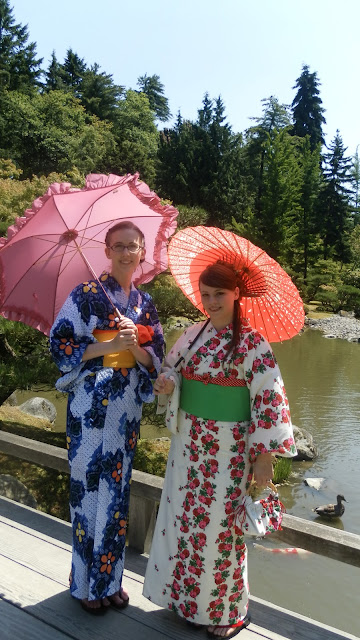Summer festivals have long since ended, and many of us have returned to school. While there are fewer festivals now than during the summertime, there are still many events coming up soon, and I will continue to monitor exciting opportunities to enjoy wearing kimono or Japanese culture. Here are some upcoming events:
Taiko Workshop
 |
| Northwest Taiko @ Seattle Cherry Blossom Fest 2010 |
Learn basic taiko drumming with Northwest Taiko.
When:
Wednesday, October 24th (7 - 9pm)
Where:
Japanese Cultural & Community Center of Washington
1414 S. Weller Street
Seattle, WA 98144
Cost:
$15, $10 for JCCCW members, $5 for students
limited to 12 students, register here.
An Evening of Traditional Japanese Music - Koto and Shakuhachi
Traditional music by Mitsuki Dazai (koto) and Kakizakai Kaoru (shakuhachi).
When:
Saturday, October 27th (8pm)
Where:
Tateuchi Theater @ Wing Luke Museum
719 South King Street, Seattle
Cost:
$20 at the door, $18 advance tickets, $12 for students
www.hakakumei.org
Tea Ceremony Workshop
Instructors Aiko Fujii and Ritsuko Kawahara will teach about basics of Urasenke tea ceremony.
When:
Monday, October 29th (6:30 - 8:30pm)
Where:
Japanese Cultural & Community Center of Washington
1414 S. Weller Street
Seattle, WA 98144
Cost:
$21, $16 for JCCCW members, $11 for students
limited to 10 students, register here.
Cultural Crossroads Festival in Bellevue
 |
| Kabuki Academy @ Cultural Crossroads 2011 (source) |
Two stages of cultural entertainment, international bazaar, and
exhibits. You can see a full schedule of performances
here. Performance of note: Japanese dance and shamisen music will be performed by the
Kabuki Academy, Saturday, November 3rd on the Dance Stage at 12:45 - 1:30pm.
When:
Friday, November 2 (5pm - 10pm)
Saturday, November 3 (10am - 10pm)
Sunday, November 4 (11am - 6pm)
Where:
Crossroads Bellevue
15600 NE 8th
Bellevue, WA 98008
Cost:
Free!
Bunka no Hi (Culture Day)
Bunka no Hi is a holiday in Japan, held on November 3rd. The JCCCW will be holding Bunka no Hi festivities on November 4th, including performances, displays, and demonstrations. There will be an onigiri rice ball contest, martial arts, tea ceremony, and of course Hosekibako will be open so you can buy Japanese antiques (and kimono!)
When:
Sunday, November 4th (11am - 5pm)
Where:
Japanese Cultural and Community Center of Washington
1414 S Weller St
Seattle, WA,
98144
Cost:
Free!
Tacoma Buddhist Temple Food and Craft Bazaar
Food includes rice curry, udon noodles, sushi, pie, mochi, and more. You may order food there, or schedule a pre-order pick up by email. Menu and pre-order instructions
here. Crafts include sumi'e paintings, pottery, handicrafts, Japanese theme rummage sale, bake sale, and fresh vegetables.
When:
Sunday, November 4th (11am - 4pm)
Where:
Tacoma Buddhist Temple
1717 S. Fawcett Ave., Tacoma
Cost:
Free. See link above for menu item prices.
Shichi-Go-San
 |
| Shichi-go-san at the Tsubaki Grand Shrine |
Shichi-go-san, an important ceremony/festival for children, boys 3 and 5 years old, and girls 3 and 7 years old! Children wear there best cloths or kimono and go to the shrine to pray with their parents for a long happy life. Kids will recieve a omamori charm, and chitose-ame long-life candy. Shichi-go-san is on November 15th, but it is observed on the nearest weekend, November 11th this year.
When:
Sunday, November 11 (10:30am registration, ceremony starts at 11am)
If you can not make it to the Nov. 11th ceremony, you may schedule an appointment for shichi-go-san blessing during the month of November. To schedule: 360-691-6389 or
Kannushi@Tsubakishrine.org
Where:
Tsubaki Grand Shrine of America
17720 Crooked Mile Rd.
Granite Falls, Washington 98252
Cost:
None that I am aware of.
Creative Bento Workshop
Learn how to make cute bento box lunches. Ingredients and bento boxes included in registration fee.
When:
Saturday, November 17 (2 - 4pm)
Where:
Japanese Cultural & Community Center of Washington
1414 S. Weller Street
Seattle, WA 98144
Cost:
$25, $20 for JCCCW members, $15 for students
limited to 20 students,
register here.
Minyo Dancing Workshop
 |
| (Japanese dance workshop, by Mary Ohno. source) |
Mary Ohno of the
Kabuki Academy will be teaching a workshop on minyo dance, folk dancing such as that done at Bon Odori.
When:
Wednesday, November 28th (6:30 - 8:30pm)
Where:
Japanese Cultural & Community Center of Washington
1414 S. Weller Street
Seattle, WA 98144
Cost:
$15, $10 for JCCCW members, $5 for students
limited to 25 students,
register here.

















































